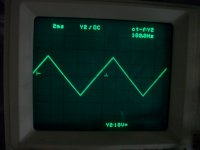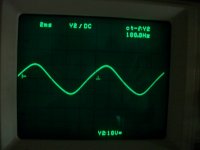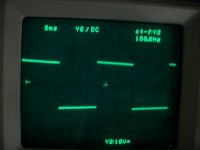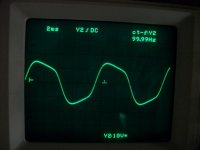I might half to bite the bullet and go with a class D amp. I will research a quality class D. Hopefully there are some amps out there that approach class A/B sound. Thanks for everybody help.
If you're asking for suggestions, you need to give specifics. Are you now looking for a full range class D or a sub only class D?
By 'quality class D' do you mean reliability or sound?
Post the make/model of the ones you're interested in to get feedback/suggestions.
What aspect of the sound quality are you expecting to sound different or unacceptable?
By 'quality class D' do you mean reliability or sound?
Post the make/model of the ones you're interested in to get feedback/suggestions.
What aspect of the sound quality are you expecting to sound different or unacceptable?
I think I'll just stick to a class D for the subwoofers. The quality would half to include longevity,and if there is a class D that sounds like,or pretty close to class A/B. That would be the one I would like. I have no model or makes to post,since I have never owned a class D and have zero experience with them.That's where I hope you guys would chime in,So I don't buy junk,with my lack of experience with class D amps.As long as it sounds like a quality oldschool class A/B amp that you know sounded clean at high volumes .Which again I know you have much more experience than me with will be fine with me. Each sub is 400rms watts.So enough headroom would be nice to prevent clipping or distortion.Thanks
I don't understand what you mean when you want it to sound like a class AB amplifier.
For virtually any commercially available solid state (non-tube) amplifiers, the amplifier stage has absolutely no 'sound' to it. The input is fed into a circuit called a differential amplifier (either discrete or in an op-amp). This has two inputs. One input receives the signal you want to amplify. The other input receives a fraction of the output signal that goes to the speakers. If there is ANY difference in the output signal that makes it differ from the input signal, the amp instantaneously corrects (inaudibly) to keep the output identical to the input except for amplitude. This means that, with almost no exceptions, two amplifiers (not including the preamp equalization and filters, just the output stage) will sound identical if they are properly designed and in good working order. This includes Class B, AB and D. They all use the global feedback to virtually eliminate any distortion in the output signal.
What about the class D amp do you expect to be different?
For virtually any commercially available solid state (non-tube) amplifiers, the amplifier stage has absolutely no 'sound' to it. The input is fed into a circuit called a differential amplifier (either discrete or in an op-amp). This has two inputs. One input receives the signal you want to amplify. The other input receives a fraction of the output signal that goes to the speakers. If there is ANY difference in the output signal that makes it differ from the input signal, the amp instantaneously corrects (inaudibly) to keep the output identical to the input except for amplitude. This means that, with almost no exceptions, two amplifiers (not including the preamp equalization and filters, just the output stage) will sound identical if they are properly designed and in good working order. This includes Class B, AB and D. They all use the global feedback to virtually eliminate any distortion in the output signal.
What about the class D amp do you expect to be different?
I don't understand. The photos appear to be a triangle and a square wave driven into two amplifiers. Neither is low frequency audio. What if you drive an 80Hz sine wave into both?
I will do some research on my own,and pick what I consider a good amp,that is reliable,and sounds good to my ears. They don't have much to audition around in my area,so it would have been nice for some suggestions. So I could order a good one. Thanks again for every ones help.
I don't understand. The photos appear to be a triangle and a square wave driven into two amplifiers. Neither is low frequency audio. What if you drive an 80Hz sine wave into both?
Its a 100Hz signal in all cases.
Neither amp is loaded.
In all fairness the low pass filter should be engaged on the class Ab amp and set to a realistic value like 80hz if you are want to do a comparison.
Even though the slew rate of the class ab amp can produce a clean square up into the Khz range once the LP filter is engaged that point is moot.
Even though the slew rate of the class ab amp can produce a clean square up into the Khz range once the LP filter is engaged that point is moot.
I believe it shows the differences and the capabilities of the two topologies and this is the reason i posted.
With triangle and square waves someone can see the precision of amplification.
With triangle and square waves someone can see the precision of amplification.
That would be applicable for a 'laboratory' amplifier that needed to amplify any waveform from DC to 100kHz (or whatever top freq) and may be a way to judge amplifiers in general but has no bearing on audio amplifiers (especially subwoofer amplifiers), as far as I'm concerned. This can be and has been argued to death on various forums. The amplifier needs to be able to accurately reproduce the spectrum of sine waves for which it's used.
Would you judge a subwoofer amplifier that produced perfect sine waves from 10-300Hz and could produce thousands of watts of power with 100% reliability for years on end but could not reproduce triangle and square waves to be a poor quality amplifier?
By your standards it would seem that you're saying an amp that could do all of that would be a poor choice for a subwoofer amplifier. Correct me if that's not what you're trying to say.
Would you judge a subwoofer amplifier that produced perfect sine waves from 10-300Hz and could produce thousands of watts of power with 100% reliability for years on end but could not reproduce triangle and square waves to be a poor quality amplifier?
By your standards it would seem that you're saying an amp that could do all of that would be a poor choice for a subwoofer amplifier. Correct me if that's not what you're trying to say.
To make myself clear, I dont belong to those who judge an amp entirely by the specs.
However, specs help a lot.
Just because we talk about a sub amp with very limited bandwidth compared to the audio spectrum, i doesnt mean it is not important in the chain of sound reproduction. its all hi fi after all.
It is difficult to see distortion in a sine wave, when it begins to be visible on the scope, its too late (too much distortion). So, by testing with triangle or square wave, we can see the the accuracy of the amp.
Additionally, other important factors like slew rate and damping factor can make a big difference.
And it is not only about the values of the above, a medium quality bass amp can have -what people call - "tail", which means inability to control the speaker.
A good amp, should not only move the cone of the speaker forward,but also bring it back.
For me, speed means precision and an amp with good damping factor will give the "tight" bass.
So its all about control.
And since we talk about hi fi, have you ever seen a class D amp used in IASCA or EMMA (for Europe) ? I think some of the above might be the reason why.
I think it is inevitable that in a few more years, class D amps will match and even overtake class AB amps in performance, but in my opinion, not yet.
However, specs help a lot.
Just because we talk about a sub amp with very limited bandwidth compared to the audio spectrum, i doesnt mean it is not important in the chain of sound reproduction. its all hi fi after all.
It is difficult to see distortion in a sine wave, when it begins to be visible on the scope, its too late (too much distortion). So, by testing with triangle or square wave, we can see the the accuracy of the amp.
Additionally, other important factors like slew rate and damping factor can make a big difference.
And it is not only about the values of the above, a medium quality bass amp can have -what people call - "tail", which means inability to control the speaker.
A good amp, should not only move the cone of the speaker forward,but also bring it back.
For me, speed means precision and an amp with good damping factor will give the "tight" bass.
So its all about control.
And since we talk about hi fi, have you ever seen a class D amp used in IASCA or EMMA (for Europe) ? I think some of the above might be the reason why.
I think it is inevitable that in a few more years, class D amps will match and even overtake class AB amps in performance, but in my opinion, not yet.
You can measure distortion in a sine wave very easily. A properly designed class D amp (especially those that take the feedback directly from the speaker terminals) isn't going to produce any more distortion than a class AB subwoofer amp.
The damping factor is not that critical. Many people think that a damping factor of 100+ is sufficient. I'd be willing to be that, in the real world, in a double-blind AB test between an amp with a high damping factor and one with a damping factor of 40 that virtually no one could pick the lower damping factor amp consistently. Just adding a few feet of speaker wire brings the effective damping factor down significantly.
The damping factor is not that critical. Many people think that a damping factor of 100+ is sufficient. I'd be willing to be that, in the real world, in a double-blind AB test between an amp with a high damping factor and one with a damping factor of 40 that virtually no one could pick the lower damping factor amp consistently. Just adding a few feet of speaker wire brings the effective damping factor down significantly.
I agree with you, measuring distortion is not that difficult, i own a distortion meter after all. But if we want to analyze the behavior of an amp, we need to go to the extremes, that is triangle and square wave testing.
Ok, first generation class D amps had a huge problem with distortion ( 100 or 1000 times more than class AB). From then on things have changed, so i would leave the distortion factor out for now, by admitting its just acceptable, not in the range of AB, but ok.
The class D amp topology you suggest has an additional feature:
with post feedback class D, the output choke is included in the feedback path, so its resistance is not affecting the damping.
During the past few months i attended several amp blind tests conducted by an EMMA certified chief judge.
He tested in pairs several top quality AB amps, and the set up allowed him to swift from one amp to the other in less that half a second.
Although the amps were tested with audiophile CDs (full range), among other differences, in a specific part of a song, one amp reproduced a long low frequency drum, like a "booom", while the other amp reproduced two very close bursts.
So actually, there were two drum hits, not one long.
In another instance, the judge went to the side of the speakers, to check the cone movement while playing (please note it is the low frequencies again).
One amp moved the cone more than the other (lower frequency response) while he commented that he could hear "more harmonics", a bit "richer sound".
Of course, i know these differences are small, but in my opinion they all add to the result.
I believe class Ab bass amps is more musical and blends nicer with the rest of the equipment.
Ok, first generation class D amps had a huge problem with distortion ( 100 or 1000 times more than class AB). From then on things have changed, so i would leave the distortion factor out for now, by admitting its just acceptable, not in the range of AB, but ok.
The class D amp topology you suggest has an additional feature:
with post feedback class D, the output choke is included in the feedback path, so its resistance is not affecting the damping.
During the past few months i attended several amp blind tests conducted by an EMMA certified chief judge.
He tested in pairs several top quality AB amps, and the set up allowed him to swift from one amp to the other in less that half a second.
Although the amps were tested with audiophile CDs (full range), among other differences, in a specific part of a song, one amp reproduced a long low frequency drum, like a "booom", while the other amp reproduced two very close bursts.
So actually, there were two drum hits, not one long.
In another instance, the judge went to the side of the speakers, to check the cone movement while playing (please note it is the low frequencies again).
One amp moved the cone more than the other (lower frequency response) while he commented that he could hear "more harmonics", a bit "richer sound".
Of course, i know these differences are small, but in my opinion they all add to the result.
I believe class Ab bass amps is more musical and blends nicer with the rest of the equipment.
Which two amplifiers were being compared in the test?
I (anyone) can significantly under-bias a class AB amplifier and give you more 'harmonics' than you ever heard. With an instrument like a cello, the under-biased amp would likely win every AB comparison unless the listener had heard the piece of music through an audiophile system. The under-biased amp would have a sense or 'airy-ness'. The properly biased amp would sound lifeless in comparison. Subjective tests are often the worst.
I don't know what they used for a test but an amp doesn't continue to produce a note between beats. All the amp can do to stop the sound is return to 0v output and remain there. The damping factor determines how well it does that but the damping factor of virtually every commercially available car amplifier is good enough to prevent the speaker's back EMF from driving it from the 0v output level.
To test this, you can bridge an amplifier and drive only one channel Look at the signal on the un-driven channel. It will remain dead (0v). If it looks noisy, you can connect a speaker to the un-driven channel to see how much the driven channel is driving it.
Don't do this for any extended period of time because the un-driven channel will be dissipating much more heat than the driven channel (even without the extra speaker on the un-driven channel).
I (anyone) can significantly under-bias a class AB amplifier and give you more 'harmonics' than you ever heard. With an instrument like a cello, the under-biased amp would likely win every AB comparison unless the listener had heard the piece of music through an audiophile system. The under-biased amp would have a sense or 'airy-ness'. The properly biased amp would sound lifeless in comparison. Subjective tests are often the worst.
I don't know what they used for a test but an amp doesn't continue to produce a note between beats. All the amp can do to stop the sound is return to 0v output and remain there. The damping factor determines how well it does that but the damping factor of virtually every commercially available car amplifier is good enough to prevent the speaker's back EMF from driving it from the 0v output level.
To test this, you can bridge an amplifier and drive only one channel Look at the signal on the un-driven channel. It will remain dead (0v). If it looks noisy, you can connect a speaker to the un-driven channel to see how much the driven channel is driving it.
Don't do this for any extended period of time because the un-driven channel will be dissipating much more heat than the driven channel (even without the extra speaker on the un-driven channel).
That's a lot of information to take in guys...wow.
If it were me I would use a Rockford BD1000 or a BD1500.
Reliable
Efficient
High output power
Minimal draw on your charging system compared to others.
BD SYNC capable as well for strapping them together
Easily repairable in most cases
Parts are easily found for repairs
Schematic readily available from Rockford
Compact design fits into almost any location
Does not require a fan
All around great amps that have proven themselves over and over.

If it were me I would use a Rockford BD1000 or a BD1500.
Reliable
Efficient
High output power
Minimal draw on your charging system compared to others.
BD SYNC capable as well for strapping them together
Easily repairable in most cases
Parts are easily found for repairs
Schematic readily available from Rockford
Compact design fits into almost any location
Does not require a fan
All around great amps that have proven themselves over and over.

Which two amplifiers were being compared in the test?
I would kindly ask for your patience, i need about 10 days. Then i would be happy to let you know everything.
I (anyone) can significantly under-bias a class AB amplifier and give you more 'harmonics' than you ever heard. With an instrument like a cello, the under-biased amp would likely win every AB comparison
One of the amps was in production in the 90's and i can confirm that noone messed with the idle current. As for the other amp, please wait a few days.
unless the listener had heard the piece of music through an audiophile system. The under-biased amp would have a sense or 'airy-ness'. The properly biased amp would sound lifeless in comparison.
Thats a good point. There was always a reference (home) set up, to compare whenever needed.
In another test, one of the car amps under comparison played an entirely different female voice.
Subjective tests are often the worst.
Yes, but i dont think it is the case here.
The chief judge has a lot of experience and of course the CDs he tested with were specifically chosen so that they bring the amps to their extremes (sonically speaking).
For example, in the 10th second of a song, a breath should be heard from the guitar player. If the amp reproduces that breath faintly, or not at all, it means it lacks in precision.
Many times he had to set the CD player back in order to test both amps in a specific point.
These people know exactly how specific songs need to be heard.
The same applies for the 2012-13 EMMA reference CD.
It is written in on of Germany's best studios (only two left) and the sound engineer owns the studio.
In songs number 12 and 13 of that CD, judges can test the low frequencies of a car installation.
In these songs there are 3 different bass recordings, and the system should follow with extreme precision. One is a recent bass recording, another one is a 25 year old recording of a string bass, and the last one is a completely artificial bass sound, created inside the studio. The sonic signature of these 3 bass sounds, is pretty close, so that a not so well tuned system comfuses them.
Its not music that will make someones system sound great, its test music.
I don't know what they used for a test but an amp doesn't continue to produce a note between beats. All the amp can do to stop the sound is return to 0v output and remain there. The damping factor determines how well it does that but the damping factor of virtually every commercially available car amplifier is good enough to prevent the speaker's back EMF from driving it from the 0v output level.
To test this, you can bridge an amplifier and drive only one channel Look at the signal on the un-driven channel. It will remain dead (0v). If it looks noisy, you can connect a speaker to the un-driven channel to see how much the driven channel is driving it.
Don't do this for any extended period of time because the un-driven channel will be dissipating much more heat than the driven channel (even without the extra speaker on the un-driven channel).
I am willing to try that, but what it will prove?
I also intend to make another test with a class D amp and share it in this thread.
Last edited:
Hi, I thought this thread died off,since I was no longer getting any emails about it. I am happy I checked back in. I would be interested in hearing those real world results.,and what amps were used. I'm sure they must be high end ,or they wouldn't bother wasting their time testing with them. I myself like real world testing,where you compare with your ears. I myself have heard many different amps,and though the specs say they should be the same.There is usually a clear difference between one or the other.Sometimes there is only a subtle difference.But none the less a difference, that the ears pick up,but the specs totally miss.If you have a chance to choose an amp that you can hear a subtle breath,as compared to an amp where it cannot be heard.I'd rather pay for the amp where you can hear every subtle detail and nuance. Though sometimes again,through my real world experience, for example with speakers.Sometimes the speaker is more detailed,but it just doesn't reproduce a full sound,and sounds thin.If the amp was more detailed but sounded thin,that would not be better either.I would also hope that after the test tones,etc were all done ,that there would be some real world music going through the amps for comparison as well.I don't play many test tones through my car for enjoyment.That's why I was going to test the amps on my front and rear stage.If it can make midbass,midrange,and tweeters sound fantastic.Then surely it will be good enough for hi end sub sound.
While I haven't kept up with the following challenge, I have never heard anyone win the $10,000. If there is truly a difference in the sound quality, why hasn't been able to get the correct amp 24/24 times?
Amplifier Challenge Rules
If someone has won the challenge, please post a link to the details.
Amplifier Challenge Rules
If someone has won the challenge, please post a link to the details.
- Status
- Not open for further replies.
- Home
- General Interest
- Car Audio
- Which is the better amp,PPI A1200.2 or Hifonics zeus VII



